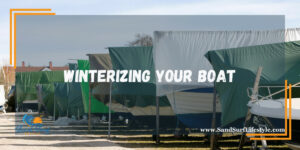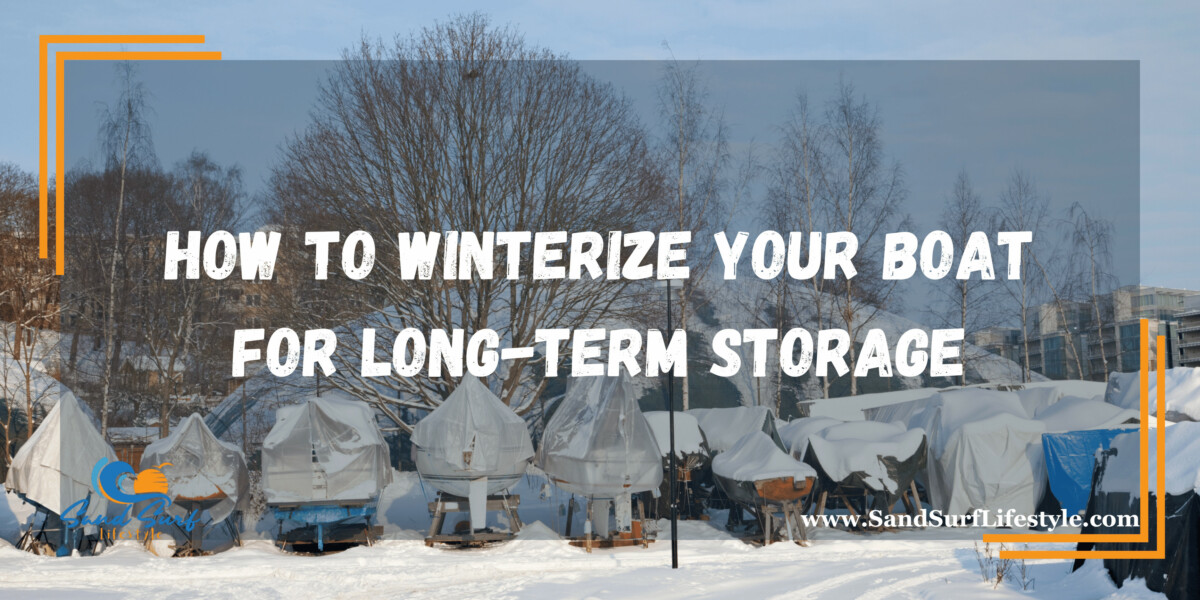As the leaves change colors and the temperature drops, it’s time for boat owners to start thinking about one crucial aspect of boat maintenance: winterization. Preparing your boat for the colder months ahead is essential to ensure its longevity and to avoid costly repairs come spring.
1. Winterizing Your Boat

Winterization is a fundamental process for boat owners, particularly those facing colder climates. Its primary objective is to safeguard your vessel during the winter when it won’t be actively used. Failing to execute a proper winterization plan can expose your boat to numerous risks and potential damage.
The significance of winterization lies in its capacity to prevent a range of issues that can plague boats left exposed to harsh winter conditions. One of the most critical concerns is engine damage, as freezing temperatures can wreak havoc on vital engine components, potentially leading to costly repairs in the spring. Additionally, freezing water can cause pipes to burst, rendering your boat’s plumbing system useless and causing substantial harm. The overall deterioration of boat components due to the cold, moisture, and lack of use is another significant threat.
To learn how to de-winterize a boat’s water system, check out this article.
2. Cleaning and Inspection
Before embarking on the essential winterization procedures, thorough cleaning and inspection of your boat are paramount. Neglecting this step can lead to corrosion and damage caused by saltwater, algae, and accumulated grime during the winter months.
Begin the cleaning process by rinsing the hull and exterior of your boat with fresh water. This step helps eliminate salt residues and debris that may have accumulated during your boating adventures. Scrubbing the boat’s interior is equally crucial, with special attention given to stains and mildew. Neglected stains can worsen over time and potentially become permanent if not addressed.
During the cleaning process, it’s also prudent to inspect the hull meticulously. Look for cracks, scratches, or any other visible damage that may require repair before storage. Addressing these issues now can prevent further deterioration during the winter months, ultimately saving you time and money in the long run.
3. Fuel System Care
Properly caring for your boat’s fuel system is among the most critical aspects of winterization, as stale fuel can lead to severe engine problems when you’re eager to get back on the water in the spring.
Start by adding a fuel stabilizer to the tank. This stabilizer prevents fuel breakdown during the storage period, ensuring that your boat’s engine will start smoothly when the warmer season arrives. Running the engine for a short period is essential after adding the stabilizer to ensure that it circulates throughout the entire system.
Furthermore, topping off the fuel tank before storage is a recommended practice. A full tank minimizes air exposure inside, reducing the chances of condensation forming within the tank, which can lead to water contamination and engine issues. By diligently attending to your boat’s fuel system, you’ll significantly enhance the chances of a trouble-free start-up when spring arrives, thus maximizing your boating enjoyment.
4. Oil Change and Lubrication
Ensuring your boat’s engine remains in top condition during the winterization process involves essential steps such as changing the oil and providing lubrication to critical components. These measures are pivotal in protecting your boat’s engine and preserving its performance.
Begin by changing the engine oil and replacing the oil filter. This step removes contaminants and old oil that may have accumulated during the boating season, promoting optimal engine health. Fresh oil helps prevent corrosion and maintains proper lubrication.
In addition to the oil change, it’s vital to lubricate all moving parts. This includes components like the steering mechanism and control cables. Adequate lubrication reduces friction and wear, extending the lifespan of these crucial elements.
To further safeguard your engine, it’s advisable to fog the engine cylinders with a corrosion inhibitor. This protective layer helps prevent rust formation, especially in regions with high humidity or near saltwater.
5. Cooling System Maintenance
The boat’s cooling system requires special attention during winterization to shield it from the adverse effects of freezing temperatures. Proper maintenance here is instrumental in preventing damage to the engine block and manifolds.
Begin by flushing the cooling system with fresh water. This step effectively eliminates any salt or debris that may have accumulated during your boating adventures. These impurities, if left unchecked, could lead to corrosion or blockages in the cooling system.
Draining the cooling system is another crucial step. By removing all water from the system, you prevent the possibility of freezing and subsequent expansion that could potentially crack components.
For added protection, consider using a non-toxic antifreeze designed specifically for marine engines. This antifreeze will help ensure that no residual water remains in the system, minimizing the risk of cold-related damage.
6. Battery Care
Proper battery care is essential during boat winterization, as cold weather can cause batteries to lose their charge or even freeze, potentially leading to permanent damage.
To safeguard your boat’s battery, begin by disconnecting it from the boat’s electrical system. Store it in a cool, dry place away from extreme temperatures and direct sunlight.
Before storage, fully charge the battery to maintain its capacity throughout the winter. You can also consider using a battery maintainer or tender to keep the battery charged at an optimal level. These devices automatically monitor and adjust the charge as needed, ensuring the battery remains in excellent condition for the upcoming boating season.
By following these battery care steps, you can avoid the hassle of a dead or damaged battery when you’re ready to hit the water again in the spring, ensuring a smoother and more enjoyable boating experience.
7. Electrical Systems
While preparing your boat for winter, it’s essential to give proper attention to the electrical systems on board, which include navigation equipment, lights, and various electronic components.
Start by inspecting all electrical connections for signs of corrosion. Corroded connections can disrupt electrical flow and lead to malfunctions. If you find any corrosion, clean the affected areas thoroughly to ensure a reliable electrical system.
To safeguard sensitive electronic equipment, remove and store it in a safe, dry place indoors. Extreme cold and moisture can be detrimental to electronics, so protecting them from these elements is crucial for their longevity.
Consider using dielectric grease on connectors to provide an additional layer of protection against moisture intrusion. This grease prevents corrosion and helps maintain the integrity of electrical connections. By addressing these electrical system maintenance tasks, you’ll ensure that your boat’s electronics remain in working order and ready for use when the boating season returns.
8. Plumbing and Water Systems
Boat owners must not overlook the plumbing and water systems during the winterization process. Freezing temperatures can cause water in the plumbing system to expand, potentially leading to burst pipes and damage.
Begin by draining all water from the plumbing system, including the fresh water tank and hot water heater. Ensure that no residual water remains in the system, as even small amounts can freeze and cause significant damage.
To protect the toilet and holding tank, use a non-toxic antifreeze designed for marine applications. This antifreeze ensures that these components won’t freeze or sustain damage during the winter months.
Additionally, remove any water-sensitive items like towels or bedding from the boat. Storing these items indoors prevents moisture-related problems and helps maintain a fresh, dry interior.
By paying attention to your boat’s plumbing and water systems during winterization, you can prevent costly repairs and ensure that these systems function smoothly when you’re back on the water in the spring.
9. Canvas and Upholstery Protection
Preserving your boat’s canvas and upholstery is essential during the winter months, as they can be vulnerable to harsh weather conditions.
Start by thoroughly cleaning and drying all canvas covers before storing them. Salt, dirt, and moisture can lead to mold and mildew if left unchecked. Applying a waterproofing agent to the canvas provides an additional layer of protection against moisture, ensuring that it remains in good condition.
When it comes to cushions and upholstery, it’s best to remove them from the boat and store them indoors if possible. Extreme cold and dampness can cause fabric and foam to deteriorate over time. Storing these items indoors prevents damage and ensures that they remain comfortable and aesthetically appealing.
By taking these steps to protect your boat’s canvas and upholstery, you’ll extend their lifespan and maintain the overall appearance and comfort of your vessel. Proper winterization ensures that your boat is in top shape when you’re ready to set sail again.
10. Trailer Maintenance
If your boat is stored on a trailer during the winter, it’s vital to address trailer maintenance as part of the overall winterization process.
Start by inspecting the trailer for any signs of damage or rust. Over time, exposure to the elements can cause wear and tear. Address any issues promptly to prevent further deterioration.
Grease the trailer’s wheel bearings to ensure smooth operation and prevent corrosion. Properly lubricated wheel bearings contribute to safe and efficient towing when you’re ready to transport your boat again.
Consider jacking up the trailer to take the weight off the tires. This precaution helps prevent flat spots on the tires, which can occur when they remain in one position for an extended period.
By including trailer maintenance in your winterization routine, you’ll not only protect your boat but also ensure that the trailer remains in good condition for future use.
11. Storage Options

Selecting the appropriate storage option for your boat is a pivotal decision in its winterization process. The choice of storage significantly impacts your boat’s protection during the winter months.
Indoor storage is the optimal choice, providing complete protection from the elements, including freezing temperatures, snow, and ice. It safeguards your boat from the harshest winter conditions, preserving its condition and appearance.
If indoor storage is not available, invest in a high-quality boat cover. A well-fitted cover shields your boat from snow, ice, and debris, reducing the risk of damage. Ensure the cover is securely fastened to prevent it from being blown off by strong winds.
Regardless of your storage choice, ensure that your boat is properly supported. Proper support helps distribute the weight evenly, preventing stress on the hull and minimizing the risk of damage.
12. Pest Prevention
During the winter months, boats in storage can attract unwelcome visitors, such as rodents seeking shelter from the cold. Implementing pest prevention measures can save you from unpleasant surprises in the spring.
Begin by sealing any openings or vents that rodents could use to access the boat. Even small gaps can be an entry point, so be thorough in your inspection and sealing efforts.
Consider using rodent-repellent products inside the boat, such as bait stations or deterrent sprays. These products can help deter pests from making your boat their winter home.
To stay ahead of potential infestations, inspect the boat periodically during the winter. Look for signs of pests, such as droppings or chewed materials, and address any issues promptly.
By taking proactive steps to prevent pests, you’ll ensure that your boat remains free from damage and unpleasant surprises when you’re ready to use it again.
13. Documentation and Maintenance Records
Don’t underestimate the importance of maintaining detailed records of your winterization efforts. Documentation serves as a valuable resource for future reference and ensures that your boat receives proper care.
Document all the steps you’ve taken during the winterization process. This record can help you follow a consistent procedure each year and prevent oversight of critical tasks.
Keep a maintenance log for your boat, noting any issues that require attention in the spring. This proactive approach ensures that you address maintenance and repair needs promptly, preventing further damage.
Store all records in a safe, dry place where they are easily accessible. Maintaining organized documentation enhances the efficiency of your boat’s winterization process and contributes to its long-term care and performance.
To learn about dinghies and yacht boat price insights, check out this article.
Conclusion
Winterizing your boat may seem like a daunting task, but by following these comprehensive steps, you can ensure that your vessel remains in top condition throughout the winter months. Proper winterization not only protects your investment but also ensures that you’ll be ready to hit the water again when the warmer weather returns. So, take the time to care for your boat now, and you’ll enjoy worry-free boating in the seasons to come.
Please note that the contents of this blog are for informational and entertainment purposes only and should not be construed as legal advice. Any action taken based on the information provided in this blog is solely at your own risk. Additionally, all images used in this blog are generated under the CC0 license of Creative Commons, which means they are free to use for any purpose without attribution.

